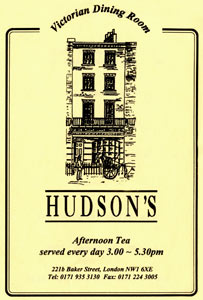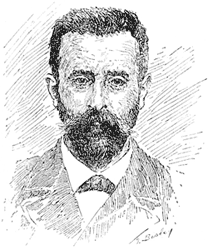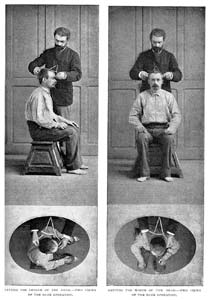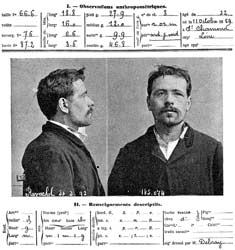Issue 3 : Hound, Chapters 1 and 2
The Hound of the Baskervilles
When Arthur Conan Doyle first published his work in The Strand Magazine in 1891, he decided to present essentially serialized works in a new way. Sherlock Holmes, the main character of Conan Doyle's two short novels, A Study in Scarlet and The Sign of Four, would also be the hero of the stories in The Strand. Instead of writing another novel and presenting a chapter per week in the magazine, Conan Doyle hit upon a new idea: he would write a series of six loosely related stories about the same characters. That way, readers could read the stories in or out of order with no concerns about continuity.
By 1901, when The Strand had published 24 Holmes stories, and
Holmes had been missing in action for eight years, Conan Doyle began
work on a longer mystery story based on an old legend from Devon about
a spectral hound that haunted a local family. It is not known whether
he intended to use Sherlock Holmes in this story from the beginning,
but, for whatever reason, Conan Doyle framed this novelette as a story
from Watson's casebooks, supposedly taking place in the late 1880s.
Unlike the earlier series of Holmes stories, Hound was serialized
in nine parts, from September 1901 to April 1902, each leaving the
narrative at an uneasy or suspenseful moment.
Nineteenth-century magazines that printed serialized literature brought mass entertainment to the middle class in an era when books were too expensive to be bought casually. The strategically placed cliffhangers that spiced up most serialized stories encouraged people to speculate about what they had read, thus bringing literature into their daily social interactions. When the long-awaited next installment finally arrived, people would gather in groups to read it aloud and savor ever word. Today, that experience is reproduced in a somewhat different form by popular weekly television series that generate what we call "water-cooler talk." The excitement of savoring a story, sharing our thoughts with friends and family, and waiting to see "what happens next" is not foreign to us, but can only be experienced in the Victorian manner by slowing down and reading a text with others who share the thrilling uncertainty of narrative possibilities.
Although The Strand's readers loved Hound, they were disappointed that Conan Doyle had not yet decided to resurrect Holmes definitively. That resurrection occurred in 1903 with "The Empty House."
I stood upon the hearth-rug and picked up the stick which
our visitor had left behind him the night before. It was a fine, thick
piece of wood, bulbous-headed, of the sort which is known as a "Penang
lawyer."
Most gentlemen carried walking-sticks in Victorian times--as a sign of status, not of infirmity. Presumably, those who walked extensively over rough terrain would put their walking-sticks to more than decorative use. Penang, formerly a British colony, is today known as Negeri Pulau Pinang and is a state of Malaya. The "Penang lawyer" is a knobbed walking stick made from a native palm.
 | |
Hudson's,
a London restaurant located at 221b Baker Street, pictures
on its menu the putative residence of Sherlock Holmes—and
they even serve coffee | |
While Watson assumes that Holmes had used his superhuman powers of deduction to ascertain what Watson is doing, he had merely used his powers of observation.
"The thick iron ferrule is worn down, so it is evident that he has done a great amount of walking with it."
A "ferrule" is the tip of a cane, the part touching the ground.
"Interesting, though elementary," said he as he returned to his favourite corner of the settee.
This is the closest that Holmes ever comes to saying, "Elementary, my dear Watson."
"Has anything escaped me?" I asked with some self-importance. "I trust that there is nothing of consequence which I have overlooked?"
"I am afraid, my dear Watson, that most of your conclusions were erroneous. When I said that you stimulated me I meant, to be frank, that in noting your fallacies I was occasionally guided towards the truth. Not that you are entirely wrong in this instance. The man is certainly a country practitioner. And he walks a good deal."
"Then I was right."
"To that extent."
"But that was all."
This wonderful bit of dialogue reveals much about the Holmes-Watson relationship. Watson's failed attempts to apply Holmes's methods give the reader a better appreciation for Holmes's unique talents, and his pride in them.
"Now, you will observe that he could not have been on the staff of the hospital, since only a man well-established in a London practice could hold such a position, and such a one would not drift into the country. What was he, then? If he was in the hospital and yet not on the staff he could only have been a house-surgeon or a house-physician—little more than a senior student."
Conan Doyle draws on his personal knowledge of the difficulties facing a doctor who wished to establish a medical practice in the 19th century.
"…and the possessor of a favourite dog, which I should describe roughly as being larger than a terrier and smaller than a mastiff."
Conan Doyle introduces a dog into the story to pique the reader's curiosity about the "Hound" of the title.
"Winner of the Jackson prize for Comparative Pathology, with essay entitled 'Is Disease a Reversion?' Corresponding member of the Swedish Pathological Society. Author of 'Some Freaks of Atavism' (Lancet, 1882). 'Do We Progress?' (Journal of Psychology, March, 1883)."
These articles all concern Victorian ideas of evolution and heredity, hotly contested by scientists at the time. Conan Doyle was born in 1859, the year Darwin's Origin of Species appeared. By the time Hound was written, Darwin's concept of evolution had been appropriated by the "Social Darwinists," who used it to support a complex array of pseudo-scientific social theories whose origins predated Darwin's work.
"Atavism" describes the recurrence of a trait that has not appeared in several generations, also known as a "throwback." In Conan Doyle's time, when heredity was not well understood, some scientists saw atavism as evidence of a return to an earlier stage of evolution. Criminals were thought to be throwbacks to more "primitive" human traits, and these traits had a Neanderthal-like physical component, as in Robert Louis Stevenson's The Strange Case of Dr. Jekyll and Mr. Hyde (1886).
By applying a scientific theory to the realm of philosophy, Social Darwinists justified racism, divisions between rich and poor, and colonialism. Darwin rejected such theories as a misuse of his work. To the well-informed Victorian reader, the titles of Mortimer's articles would plant the subtle suggestion that the "Hound" might be a prehistoric throwback.
"And now, Dr. James Mortimer—"
"Mister, sir, Mistera humble M.R.C.S."
Member of the Royal College of Surgeons, a degree that allowed a doctor to perform basic procedures and minor surgery. In Victorian times, it was one of the least prestigious medical degrees.
"A dabbler in science, Mr. Holmes, a picker up of shells on the shores of the great unknown ocean."
Mortimer paraphrases a famous line from the memoirs of physicist and mathematician Sir Isaac Newton (1642-1727): "I seem to have been only like a boy playing on the seashore, and diverting myself in now and then finding a smoother pebble or a prettier shell than ordinary, whilst the great ocean of truth lay all undiscovered before me."
"I presume that it is Mr. Sherlock Holmes whom I am addressing and not—"
"No, this is my friend Dr. Watson."
By this time, both Holmes and Watson are famous.
 |
Alphonse
Bertillon, inventor of anthropometry, from McClure's Magazine, March 1894 |
"I had hardly expected so dolichocephalic a skull or such well-marked supra-orbital development. Would you have any objection to my running my finger along your parietal fissure? A cast of your skull, sir, until the original is available, would be an ornament to any anthropological museum. It is not my intention to be fulsome, but I confess that I covet your skull."
Mortimer means that Holmes has a long head and a developed forehead. He would like to run his finger along the top of Holmes's head, where the bony plates join.
His terminology comes from phrenology, a 19th-century, pseudo-scientific practice, which held that the qualities of intelligence and personality could be read from the shape of the brain, and therefore from the shape of the skull. Various parts of the brain were considered to be the seat of certain qualities, functions, or passions. Today, we know this to be true, but the phrenological map was almost completely inaccurate, and its practice was spurious. By Conan Doyle's time, phrenology had passed out of serious consideration as a science and into the realm of "common knowledge."
Head measurements
being taken according to Bertillon's system, from McClure's
Magazine, March 1894 |
"To the man of precisely scientific mind the work of Monsieur Bertillon must always appeal strongly."
"Then had you not better consult him?"
Alphonse Bertillon (1853-1914), French police official and pioneer in forensics and identity science, invented the "mug shot" and developed anthropometry, a system of bodily measurements meant to reliably identify individuals. This system, never foolproof, was replaced by fingerprinting, which, in turn, is slowly being replaced by DNA testing. The most famous illustration of the weakness of Bertillon's system is the story of Will West and William West, two inmates incarcerated at Leavenworth in 1901 and 1903, who had identical measurements and nearly identical names. Their fingerprints, however, were different.
Holmes is right to resent the comparison. Bertillon is infamous for being the handwriting "expert" whose inaccurate testimony convicted Captain Alfred Dreyfus for treason in 1894.
A facsimile of
the "anthropometic card" of a French anarchist named Ravachol—notice
the "mug-shot," similar to those used today |
Devonshire, or Devon as it is most commonly called today, is a county in southwest England known for its wild, rugged landscape. Dartmoor, the dangerous setting of The Hound of the Baskervilles, is today a British national park.
"You will observe, Watson, the alternative use of the long s and the short. It is one of several indications which enabled me to fix the date."
Holmes could very well deduce a range of dates for the document's age. The long s, or ƒ, which resembles an f, had a long and complex history in English, and was used within the body of a word when two s's occurred together. By the end of the 18th century, this practice had died out.
"…in the time of the Great Rebellion (the history of which by the learned Lord Clarendon I most earnestly commend to your attention)…."
Edward Hyde, Lord Clarendon (1609-1674), was an advisor to Kings Charles II while both were in exile. He wrote a six-volume history of the English Civil War from a royalist point of view called A History of the Great Rebellion.
"…it came to pass that one Michaelmas…"
September 29, the feast day of the Archangel Michael in the Christian calendar.
"…nouveaux riches…."
Those made newly rich by commerce, as opposed to those who inherit long-established wealth.
"The moor is very sparsely inhabited…."
Dartmoor, a granite plateau stretching over hundreds of acres through Devon in the southwest of England, is a windswept wilderness of peat bogs and granite outcroppings. Sheep and wild ponies run free, although the extreme weather conditions make life difficult for animals, and even for plants.
"…and many a charming evening we have spent together discussing the comparative anatomy of the Bushman and the Hottentot."
Again, Mortimer's interest in Social Darwinism is evident. Today, scientists can determine the heredity of a person from skeletal evidence. Social Darwinists, on the other hand, attempted to establish an evolutionary hierarchy based on bodily measurements and characteristics. This hierarchy went hand-in-hand with colonialism, since it was used to find "scientific" reasons why the white race should dominate all others. The distinction between "Hottentot" and "Bushman" was based on misconceptions by colonials. Today these names are considered offensive, and "Khoisan" is preferred.

